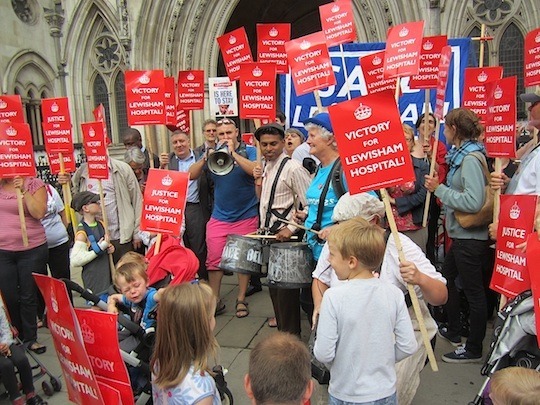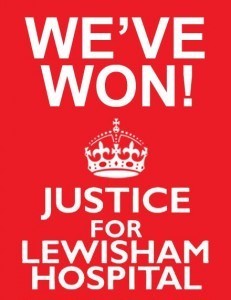Lewisham Hospital Saved! Judge Rules Jeremy Hunt’s Downgrade Plans Unlawful
 We won! Congratulations to the tens of thousands of campaigners who have been fighting to save Lewisham Hospital for the last eight months, since plans to severely downgrade services at the hospital were first announced.
We won! Congratulations to the tens of thousands of campaigners who have been fighting to save Lewisham Hospital for the last eight months, since plans to severely downgrade services at the hospital were first announced.
Today in the High Court, Mr. Justice Silber, ruling on two judicial reviews submitted by the Save Lewisham Hospital campaign and Lewisham Council, ruled that the health secretary, Jeremy Hunt, had acted unlawfully when he approved proposals by an NHS Special Administrator, Matthew Kershaw, to severely downgrade services at Lewisham Hospital. The ruling is here.
This was a stunning victory for campaigners — myself included — who have fought the proposals for the last nine months, ever since they were announced at the end of October 2012 by Matthew Kershaw, an NHS Special Administrator appointed to deal with the debts of a neighbouring NHS trust, the South London Healthcare Trust, based in the boroughs of Greenwich, Bexley and Bromley, which was losing over £1m a week, partly through ruinous PFI deals.
Kershaw’s plans involved shutting the A&E Department, including children’s A&E, so that the majority of the 110,000 people seen every year in Lewisham would have to go elsewhere — particularly to Queen Elizabeth Hospital in Woolwich, one of the SLHT’s hospitals, which is to merge with Lewisham. The plans also involved the loss of other acute services, cutting maternity services so that only 1 out of every 10 mothers in Lewisham would be able to give birth in the borough, and selling off 60 percent of the hospitals’ buildings and land.
Kershaw was the first appointment under the Unsustainable Providers Regime, legislation initially passed by the Labour government for dealing with NHS trusts facing serious financial problems, but from the beginning it was clear that it was unacceptable to downgrade Lewisham Hospital — run by a solvent NHS trust — as part of the solution to the problems of the SLHT.
That obvious unfairness — plus the downgrade of maternity services and the closure of A&E, requiring a journey to Woolwich that can take up to two hours on public transport at rush hour — led to the creation of a huge grassroots campaign, which involved 15,000 people attending a march and rally in the rain in November, and 25,000 people attending another march and rally in January (and also see here), just before Jeremy Hunt approved Matthew Kershaw’s proposals.
In response, the two judicial reviews were launched. The council’s legal challenge was based on the powerful claim that “the decisions are beyond the powers set out in the Unsustainable Provider Regime. The UPR confers powers on a Trust Special Administrator and on the Secretary of State respectively to make recommendations, and to take action, about the NHS Trust to which the TSA has been appointed, in this case the South London Healthcare NHS Trust. It confers no powers to take action about and NHS Trust, such as Lewisham Healthcare, to which a TSA has not been appointed.”
The Save Lewisham Hospital campaign’s legal challenge focused on four tests that were supposed to have been satisfied for the recommendations to be approved — that there was a clinical evidence base underpinning the proposals; that the changes have the support of the GP commissioners involved; that the changes must genuinely promote choice for their patients; and that the public, patients and local authorities have been genuinely engaged.
 In approving the legal challenges, Mr. Justice Silber backed the council’s challenge, and also accepted that one of the four requirements in the Save Lewisham Hospital campaign’s challenge had not been met. As the Independent described it, he “ruled that the administrator had no powers to make decisions affecting Lewisham or any hospital outside SLHT, and Mr. Hunt had breached the provisions of the National Health Services Act 2006 when he approved the plans.”
In approving the legal challenges, Mr. Justice Silber backed the council’s challenge, and also accepted that one of the four requirements in the Save Lewisham Hospital campaign’s challenge had not been met. As the Independent described it, he “ruled that the administrator had no powers to make decisions affecting Lewisham or any hospital outside SLHT, and Mr. Hunt had breached the provisions of the National Health Services Act 2006 when he approved the plans.”
Mr. Justice Silber also ruled that the TSA and the government had failed to demonstrate that the proposed changes had “the support of the GP commissioners involved,” something made abundantly clear in the powerful submission by Helen Tattersfield, the Chair of the Lewisham Clinical Commissioning Group, which I made available here.
The government has threatened to appeal, but I can’t see how that can be anything other than an empty threat. More worrying is the Independent noting that, although the ruling “has cast serious doubts over the powers of Trust Special Administrators,” the Department of Health is understood to be “examining whether it could change legislation to expand their powers so that they could authorise broader service shake-ups beyond their trust.”
For now, as we celebrate this rare victory over the government, which is inspiring people up and down the country to believe that resistance is not futile, it is important to remember that we now need to be alert to the details of the merger of Lewisham and the Queen Elizabeth, which is going ahead, and also to watch out for what the senior NHS managers who backed Matthew Kershaw’s proposals will do next.
Personally, I believe that serious questions about the competence of these individuals — and their commitment to the NHS — need to be asked, particularly about Dr. Jane Fryer, the medical director of the NHS in south east London, who was Matthew Kershaw’s chief medical advisor, but also about Dr. Andy Mitchell, the medical director of NHS London, who also played a role in supporting the recommendations, and Sir Bruce Keogh, the medical director of the NHS in the whole of England.
As I explained after one of the sham consultations that the TSA held in November and December, “The biggest insult of the night … was when Dr. Jane Fryer brushed aside complaints about the Special Administrator’s lack of a mandate for his planned destruction of Lewisham Hospital by stating that the carve-up of the SLHT had provided a timely opportunity for the reorganisation of NHS services across south east London, which would have happened anyway, but just a little later.” I don’t believe that Dr. Fryer has been held to account for her comments, but I think she should be, and I also believe that she provided an indication of why, without a serious shake-up of NHS management, the plans to destroy Lewisham will return at some point.
For now, however, everyone involved in the campaign that led to this hugely important success in the High Court deserves to take some time to bask in this moment. Victory is possible!
 Andy Worthington is a freelance investigative journalist, activist, author, photographer and film-maker. He is the co-founder of the “Close Guantánamo” campaign, and the author of The Guantánamo Files: The Stories of the 774 Detainees in America’s Illegal Prison (published by Pluto Press, distributed by Macmillan in the US, and available from Amazon — click on the following for the US and the UK) and of two other books: Stonehenge: Celebration and Subversion and The Battle of the Beanfield. He is also the co-director (with Polly Nash) of the documentary film, “Outside the Law: Stories from Guantánamo” (available on DVD here – or here for the US).
Andy Worthington is a freelance investigative journalist, activist, author, photographer and film-maker. He is the co-founder of the “Close Guantánamo” campaign, and the author of The Guantánamo Files: The Stories of the 774 Detainees in America’s Illegal Prison (published by Pluto Press, distributed by Macmillan in the US, and available from Amazon — click on the following for the US and the UK) and of two other books: Stonehenge: Celebration and Subversion and The Battle of the Beanfield. He is also the co-director (with Polly Nash) of the documentary film, “Outside the Law: Stories from Guantánamo” (available on DVD here – or here for the US).
To receive new articles in your inbox, please subscribe to Andy’s RSS feed — and he can also be found on Facebook (and here), Twitter, Flickr and YouTube. Also see the four-part definitive Guantánamo prisoner list, “The Complete Guantánamo Files,” an ongoing, 70-part, million-word series drawing on files released by WikiLeaks in April 2011. Also see the definitive Guantánamo habeas list and the chronological list of all Andy’s articles.
Please also consider joining the “Close Guantánamo” campaign, and, if you appreciate Andy’s work, feel free to make a donation.
Andy Worthington's Blog
- Andy Worthington's profile
- 3 followers



